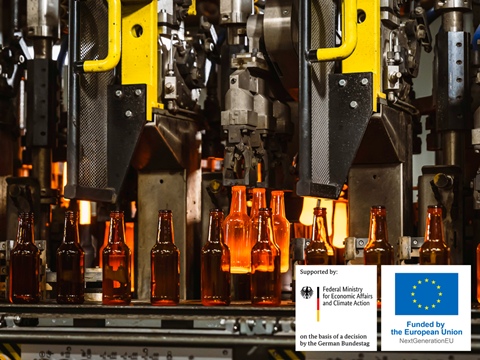
Ardagh Glass Packaging-Europe (AGP-Europe) claims that the glass bottles produced at its NextGen Furnace have saved around 18,000 tonnes of CO2 since the start of 2024, apparently achieving a consistent CO2 emissions reduction of 64%.
The furnace is located in Obernkirchen, Germany, and began commercial production in October 2023. Since then, AGP-Europe reports that it has steadily increased its direct electrical heating via electrodes, aiming to achieve its goal of 80% electrical heating and 20% gas.
So far, it claims to have reached an average rate of 60% electrical heating, which it attributes to the ‘support and expertise’ of furnace supplier SORG. It also highlights its commercial-scale output of up to 350 tonnes of amber glass, utilizing up to 70% recycled glass cullet.
Funding for the NextGen Furnace is provided by the ‘NextGeneration EU’ European Innovation Fund alongside the Bundesministerium fur Wirtschaft und Klimaschutz’s ‘Decarbonisation of Industry’ programme, which is managed by the Klimaschutz in Energieintensiven Industrien.
“Ramping up the electrical heating in the NextGen Furnace has not been an easy journey,” says Joris Goossens, R&D project manager at AGP-Europe. “In a conventional furnace, the combustion space is hotter than the glass, but in the NextGen Furnace, the glass gets hotter than the combustion space: the furnace is effectively upside down. We have been navigating uncharted territory.”
“The NextGen design, which features electrodes in the bottom of the furnace, has challenged traditional furnace operating rules,” Sven-Roger Kahl, manager of Furnace Operations at AGP-Europe, continues. “It has been like learning to drive again, but it has been worth the effort to reach our goal of low-carbon glass packaging.”
From 2027 onward, AGP-Europe plans to undertake furnace rebuilds using hybrid and other sustainability-minded melting technologies, assuming it can access the appropriate electrical infrastructure in the relevant markets.
AGP previously compared the furnace’s operations to the estimated 90% gas and 10% electricity used in conventional container glass production. It hoped that its new facility would be the first of its kind to run mostly on renewable energy and intended to lower the carbon footprint of glass packaging.
It also agreed to purchase glass recycler Svensk Glasåtervinning in April. The move aims to secure AGP-Europe’s access to high-quality glass cullet and keep recycled glass within Sweden to establish a circular economy, rather than exporting the recyclate for use in other industries.
If you liked this story, you might also enjoy:
How are the top brands progressing on packaging sustainability?
The ultimate guide to global plastic sustainability regulation
















No comments yet